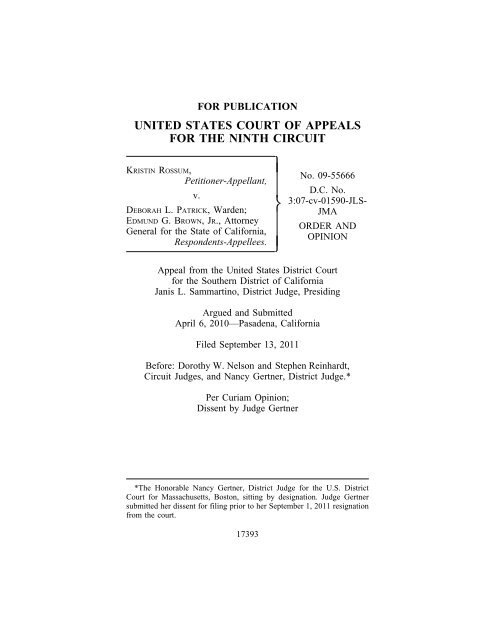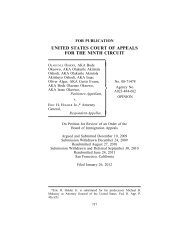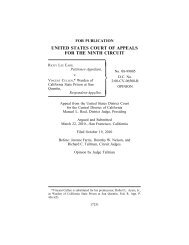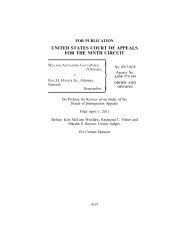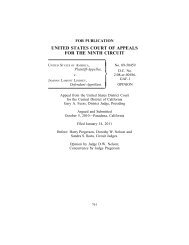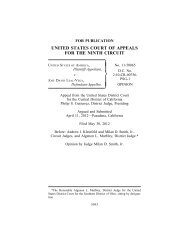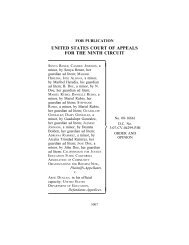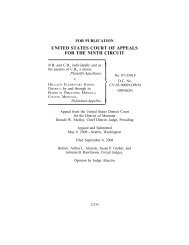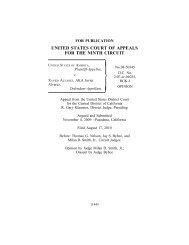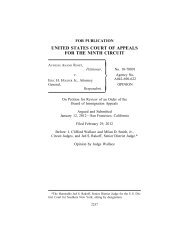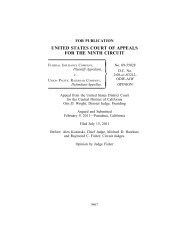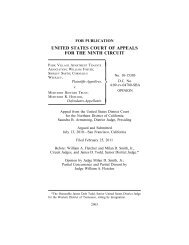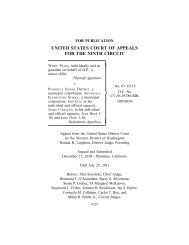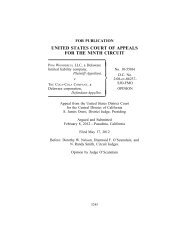kristin rossum v. deborah patrick - Ninth Circuit Court of Appeals
kristin rossum v. deborah patrick - Ninth Circuit Court of Appeals
kristin rossum v. deborah patrick - Ninth Circuit Court of Appeals
You also want an ePaper? Increase the reach of your titles
YUMPU automatically turns print PDFs into web optimized ePapers that Google loves.
FOR PUBLICATION<br />
UNITED STATES COURT OF APPEALS<br />
FOR THE NINTH CIRCUIT<br />
KRISTIN ROSSUM,<br />
No. 09-55666<br />
Petitioner-Appellant,<br />
D.C. No.<br />
v.<br />
3:07-cv-01590-JLS-<br />
DEBORAH L. PATRICK, Warden; JMA<br />
EDMUND G. BROWN, JR., Attorney<br />
ORDER AND<br />
General for the State <strong>of</strong> California,<br />
OPINION<br />
Respondents-Appellees.<br />
Appeal from the United States District <strong>Court</strong><br />
for the Southern District <strong>of</strong> California<br />
Janis L. Sammartino, District Judge, Presiding<br />
Argued and Submitted<br />
April 6, 2010—Pasadena, California<br />
Filed September 13, 2011<br />
Before: Dorothy W. Nelson and Stephen Reinhardt,<br />
<strong>Circuit</strong> Judges, and Nancy Gertner, District Judge.*<br />
Per Curiam Opinion;<br />
Dissent by Judge Gertner<br />
*The Honorable Nancy Gertner, District Judge for the U.S. District<br />
<strong>Court</strong> for Massachusetts, Boston, sitting by designation. Judge Gertner<br />
submitted her dissent for filing prior to her September 1, 2011 resignation<br />
from the court.<br />
17393
17394 ROSSUM v. PATRICK<br />
COUNSEL<br />
William J. Genego, Nasatir, Hirsch, Podberesky & Genego,<br />
Santa Monica, California, for the petitioner-appellant.<br />
Edmund G. Brown Jr., Attorney General, Dane R. Gillette,<br />
Chief Assistant Attorney General, Gary W. Schons, Senior<br />
Assistant Attorney General, Kevin Vienna, Supervising Deputy<br />
Attorney General, Kyle Niki Shaffer, Deputy Attorney<br />
General, San Diego, California, for the respondent-appellee.<br />
ORDER<br />
Respondents’ petition for panel rehearing is hereby granted.<br />
The opinion filed on September 23, 2010, and published at<br />
622 F.3d 1262 (9th Cir. 2010), is withdrawn and replaced by<br />
the attached opinion.
No new petitions for panel rehearing shall be accepted in<br />
this case.<br />
PER CURIAM:<br />
OPINION<br />
We conclude that this case is now controlled by the<br />
Supreme <strong>Court</strong>’s intervening decision in Harrington v. Richter,<br />
562 U.S. ___, 131 S.Ct. 770 (2011). Accordingly, we<br />
affirm the district court’s denial <strong>of</strong> Kristin Rossum’s petition<br />
for a writ <strong>of</strong> habeas corpus.<br />
AFFIRMED.<br />
ROSSUM v. PATRICK<br />
GERTNER, District Judge, dissenting:<br />
17395<br />
I respectfully dissent. While I appreciate the extent to<br />
which the Supreme <strong>Court</strong>’s decisions in Harrington v. Richter,<br />
562 U.S. ___, 131 S. Ct. 770 (2011), and Cullen v. Pinholster,<br />
563 U.S. ___, 131 S. Ct. 1388 (2011) require that we<br />
rehear this case and reconsider the panel’s original decision,<br />
I nevertheless find that our original conclusions — reversing<br />
and remanding the case for an evidentiary hearing on both<br />
prongs <strong>of</strong> Strickland v. Washington, 466 U.S. 668 (1984) —<br />
were entirely appropriate. The substantive finding <strong>of</strong> a Strickland<br />
violation in this case fits squarely within the rule <strong>of</strong><br />
Richter; the relief ordered—an evidentiary hearing—fits<br />
within the requirements <strong>of</strong> Pinholster.<br />
Kristin Rossum (“Rossum”) was convicted <strong>of</strong> murdering<br />
her husband, Gregory de Villers (“de Villers”). The prosecution’s<br />
theory was that Rossum poisoned him using fentanyl,<br />
a powerful synthetic opiate. Her conviction was upheld on
17396 ROSSUM v. PATRICK<br />
direct review at all levels. After the final denial <strong>of</strong> relief, Rossum,<br />
represented by new counsel, filed a habeas petition<br />
before the California Supreme <strong>Court</strong>, raising the same issues<br />
as the instant petition, presenting the same expert declaration<br />
and seeking the same relief, an evidentiary hearing. It was<br />
summarily denied. The federal district court, adopting the recommendations<br />
<strong>of</strong> the magistrate judge, followed suit, rejecting<br />
Rossum’s petition.<br />
In Rossum v. Patrick, 622 F.3d 1262 (9th Cir. 2010) (withdrawn),<br />
we reversed. Since the state habeas decision was a<br />
summary denial, we reviewed the decision de novo. Based on<br />
the four corners <strong>of</strong> the state trial and habeas record, we found<br />
that Rossum had made a strong showing that her lawyer’s performance<br />
was deficient under the first prong <strong>of</strong> Strickland v.<br />
Washington, 466 U.S. 668 (1984), and that the state court’s<br />
contrary determination was unreasonable. We remanded for<br />
an evidentiary hearing, focused on the question <strong>of</strong> whether<br />
Rossum was prejudiced by counsel’s deficient performance.<br />
Respondent moved for a rehearing initially on the scope <strong>of</strong> the<br />
remand, but subsequently, based on Richter and Pinholster.<br />
The case against Rossum hinged in large measure on toxicological<br />
and medical evidence which was equivocal. The<br />
fentanyl levels in de Villers’s autopsy samples were extraordinarily,<br />
even unnaturally, high. And while these elevated levels<br />
suggested that death was immediate, they were at odds with<br />
medical evidence which indicated that de Villers lingered for<br />
several hours before he died. There was also a plausible alternative<br />
theory <strong>of</strong> death, accidental overdose <strong>of</strong> cold medicines<br />
and oxycodone. A conceded lapse in the chain <strong>of</strong> custody <strong>of</strong><br />
de Villers’s autopsy specimens raised the not insubstantial<br />
chance <strong>of</strong> contamination, that is, that the fentanyl was added<br />
to the samples after de Villers’s death. Both Rossum and her<br />
lover worked at the San Diego County Office <strong>of</strong> the Medical<br />
Examiner (OME), which ordinarily would have performed the<br />
toxicological analysis. While the OME was sufficiently concerned<br />
about the possibility <strong>of</strong> a conflict <strong>of</strong> interest to send the
ROSSUM v. PATRICK<br />
17397<br />
samples to another lab for testing, they were stored in an<br />
unsecured refrigerator at the OME for thirty-six hours. In<br />
addition to opportunity, there was motive to contaminate<br />
because <strong>of</strong> the various personal relationships among the<br />
OME’s employees.<br />
Under the circumstances, the failure <strong>of</strong> Rossum’s attorneys<br />
to have de Villers’s autopsy samples tested for fentanyl<br />
metabolites, a test that would have resolved whether de Villers<br />
had in fact ingested fentanyl or whether fentanyl found in<br />
the samples was a product <strong>of</strong> laboratory contamination subsequent<br />
to his death, could have been critical. Rather than investigating<br />
this possibility, Rossum’s counsel conceded that the<br />
cause <strong>of</strong> death was fentanyl; the defense theory was suicideby-fentanyl,<br />
which was implausible in the light <strong>of</strong> the toxicological<br />
evidence. If testing indicated that the fentanyl found<br />
in the samples had never been in de Villers’s body, the prosecution’s<br />
theory that fentanyl was the cause <strong>of</strong> death would<br />
have been proven wrong.<br />
The panel remanded the case to the district court to hold an<br />
evidentiary hearing. Rossum, 622 F. 3d at 1275-76. The state<br />
trial record was inadequate to decide the Strickland question<br />
precisely because trial counsel failed to develop the evidence<br />
outlined in Rossum’s state Supreme <strong>Court</strong> habeas petition.<br />
And the state habeas record was likewise inadequate because<br />
it only provided the one sided conclusions <strong>of</strong> petitioner’s fentanyl<br />
expert in affidavit form. Without a hearing it was necessarily<br />
untested by cross examination or the evidence <strong>of</strong> a<br />
competing expert.<br />
Indeed, the respondent’s initial Petition for Rehearing <strong>of</strong><br />
the panel decision underscored the importance <strong>of</strong> holding an<br />
evidentiary in a case such as the one at bar. Respondents reasonably<br />
wanted to make certain that they would be permitted<br />
to call witnesses to counter the petitioner’s expert’s declaration,<br />
and to cross examine the declarant. In addition, they<br />
sought to present evidence challenging counsel’s alleged defi-
17398 ROSSUM v. PATRICK<br />
cient performance (Strickland’s first prong) as well as show<br />
that petitioner was not prejudiced by counsel’s alleged ineffectiveness<br />
(Strickland’s second prong).<br />
Neither Richter nor Pinholster should change the panel’s<br />
original conclusions. To be sure, Richter mandates deference<br />
even to the California Supreme <strong>Court</strong>’s summary denial <strong>of</strong> the<br />
habeas petition. And deference means that we are to hypothesize<br />
the arguments that “could have been made to support the<br />
state court’s decision,” and then determine if “fair minded<br />
jurists could disagree” as to whether these arguments were<br />
unreasonable under federal law. Richter, 131 S. Ct. at 786. In<br />
addition, where the right at issue is ineffective assistance <strong>of</strong><br />
counsel, habeas review is “doubly” deferential. Id. at 788. But<br />
even applying these standards, I conclude that no “fair minded<br />
jurist could disagree” that the arguments that could have been<br />
made in support <strong>of</strong> the state decision—particularly the decision<br />
to deny a hearing on these facts—were unreasonable<br />
under Strickland. Richter, 131 S. Ct. at 785-86.<br />
Richter is wholly distinguishable by the substantial evidence<br />
in that case <strong>of</strong> the petitioner’s guilt, as well as the plausible<br />
reasons for not pursuing the forensic testing on which<br />
the Strickland violation was premised. In contrast, in the case<br />
at bar, if the fentanyl metabolite test demonstrated the absence<br />
<strong>of</strong> metabolites in the autopsy samples, the government’s theory<br />
<strong>of</strong> murder would have been demonstrably erroneous. On<br />
this record, I can conceive <strong>of</strong> no plausible reason for counsel<br />
to have not conducted the test.<br />
And, while Pinholster narrowed the circumstances under<br />
which a federal court can order an evidentiary hearing, I<br />
believe that the instant case falls within those narrow circumstances.<br />
In Pinholster, the <strong>Court</strong> was concerned about a federal<br />
ruling based on facts no state court had had an<br />
opportunity to evaluate. The Pinholster majority did not<br />
address the situation here (although it was raised in the<br />
concurrence)—where the untested facts in the state habeas
ecord made out a strong showing <strong>of</strong> a Strickland violation,<br />
and the state’s contrary determination was unreasonable.<br />
Under such circumstances, the critical question is whether<br />
those facts are true, precisely what an evidentiary hearing<br />
seeks to uncover and which the state court unreasonably<br />
denied.<br />
It cannot be that a federal court is obliged to repeat the state<br />
court’s error. Without a hearing both sides are disadvantaged.<br />
It would be unfair to the government to assume the truthfulness<br />
<strong>of</strong> the expert’s untested declaration and order habeas<br />
relief. And, it would be equally unfair to Rossum to conclude<br />
that she is entitled to no relief in federal court in the face <strong>of</strong><br />
a strong showing <strong>of</strong> a constitutional violation which the state<br />
court precluded her from developing. Nothing in Pinholster<br />
requires that result.<br />
Accordingly, I would remand for an evidentiary hearing.<br />
I. Factual Background<br />
ROSSUM v. PATRICK<br />
BACKGROUND<br />
17399<br />
I recite the facts in detail because they underscore the circumstantial<br />
nature <strong>of</strong> the case and the centrality <strong>of</strong> the forensic<br />
testing issue. Rossum and de Villers married in 1999. In<br />
2000, Rossum was hired as a toxicologist at the OME.<br />
Around the time <strong>of</strong> her hiring, the OME appointed Michael<br />
Robertson to the position <strong>of</strong> Forensic Laboratory Manager.<br />
Robertson, a new hire, replaced Russ Lowe, a longtime<br />
employee who had been serving as acting laboratory manager.<br />
Rossum and Robertson—who, like Rossum, was married at<br />
the time—began having an affair. Lowe and OME toxicologist<br />
Catherine Hamm testified that some <strong>of</strong> Rossum’s<br />
coworkers resented her for it, believing that she might receive<br />
special treatment from Robertson, who was her supervisor.
17400 ROSSUM v. PATRICK<br />
On Thursday, November 2, 2000, de Villers confronted<br />
Rossum about his suspicion that she was using drugs (she had<br />
abused methamphetamines in college), and worse, that she<br />
was having an affair with Robertson. He threatened that if she<br />
did not resign, he would reveal both her drug use and her<br />
affair.<br />
Rossum testified that when de Villers awoke on the morning<br />
<strong>of</strong> Monday, November 6, he seemed “out <strong>of</strong> it.” At 7:42<br />
a.m., she left a message at his workplace stating that he was<br />
ill and probably would not come to work that day. Rossum<br />
went to work soon thereafter; coworkers saw her crying in<br />
Robertson’s <strong>of</strong>fice. That afternoon, she went back and forth<br />
from her work to her apartment. At midday, according to Rossum,<br />
she ate lunch with her husband. When she asked him<br />
why he had been so “out <strong>of</strong> it” that morning, he told her that<br />
he had taken some <strong>of</strong> her oxycodone and clonazepam, which<br />
she had obtained years earlier when she was trying to end her<br />
methamphetamine addiction. According to Rossum, de Villers<br />
went back to bed after lunch, and she returned to work.<br />
Rossum left work at 2:30 p.m. and stayed with Robertson<br />
until about 5:00 p.m., when she went back to her apartment,<br />
leaving again at 6:30 p.m. to run errands. Upon her return at<br />
about 8:00 p.m., de Villers appeared to be sleeping. After a<br />
bath and shower, she found that de Villers was not breathing.<br />
Rossum called 911 at 9:22 p.m. The operator instructed her<br />
to move de Villers’s body to the floor and attempt CPR.<br />
When paramedics arrived, they found his body on the floor<br />
with red rose petals strewn around him. 1 Rossum initially told<br />
the paramedics that he had not taken any drugs as far as she<br />
knew, but later told them that he may have taken oxycodone.<br />
1 The parties disputed the source <strong>of</strong> the rose at trial. See Rossum, 622<br />
F.3d at 1266 n.2.
ROSSUM v. PATRICK<br />
17401<br />
De Villers was pronounced dead at 10:19 p.m. While at the<br />
hospital, Rossum told a nurse that de Villers may have overdosed<br />
on oxycodone.<br />
Dr. Brian Blackbourne, the San Diego County Medical<br />
Examiner, who performed de Villers’s autopsy, determined<br />
that de Villers had been dead for at least an hour before the<br />
paramedics arrived. He concluded that de Villers had developed<br />
early bronchopneumonia, a condition that results when<br />
secretions that are normally removed by the breathing process<br />
accumulate in the lungs because the person is “unconscious or<br />
not breathing very deeply.” He also noted that de Villers had<br />
a substantial amount <strong>of</strong> urine in his bladder, an amount which<br />
would have been “very uncomfortable” to a conscious person.<br />
The combination <strong>of</strong> the two—the bronchopneumonia in de<br />
Villers’s lungs and the amount <strong>of</strong> urine in his bladder—led<br />
Dr. Blackbourne to conclude that de Villers had been not<br />
breathing properly for approximately six to twelve hours prior<br />
to his death.<br />
Lloyd Amborn, the OME’s operations administrator,<br />
decided to send the autopsy samples to an outside laboratory<br />
to avoid any potential conflict <strong>of</strong> interest; this was the first<br />
time that he ordered an outside lab to conduct such tests. The<br />
specimens were placed in a cardboard box, with each container<br />
marked as a sample taken from de Villers’s body. They<br />
were supposed to be transported to the sheriff’s <strong>of</strong>fice for<br />
transfer to the outside lab, but, since the individual who was<br />
to receive the samples was not immediately available, the box<br />
was taken to the OME. It remained in an OME refrigerator for<br />
approximately thirty-six hours until it was taken to the sheriff’s<br />
crime lab on the morning <strong>of</strong> Thursday, November 9,<br />
2000.<br />
While the autopsy specimens were at the OME, anyone<br />
with a key to the building had access to them. The containers<br />
were not sealed; their tops could be pulled <strong>of</strong>f and then<br />
replaced. Indeed, on Wednesday, November 8, 2000, Robert-
17402 ROSSUM v. PATRICK<br />
son commented to one <strong>of</strong> the toxicologists at the OME that he<br />
had looked at a sample <strong>of</strong> de Villers’s stomach contents.<br />
That same day, November 8, Russ Lowe—the veteran<br />
OME employee who served as acting laboratory manager<br />
before Robertson supplanted him—called the police to report<br />
Rossum’s and Robertson’s affair. Lowe’s call was a turning<br />
point in the investigation, focusing the police’s attention on<br />
the possibility <strong>of</strong> foul play.<br />
Toxicology tests showed that de Villers’s autopsy specimens<br />
contained extraordinarily high concentrations <strong>of</strong> fentanyl,<br />
as well as a smaller amount <strong>of</strong> clonazepam and a trace<br />
level <strong>of</strong> oxycodone. Dr. Blackbourne characterized the concentration<br />
<strong>of</strong> clonazepam found in de Villers’s blood as a high<br />
therapeutic level, but not at the level <strong>of</strong> an overdose and “not<br />
fatal.” He conceded, however, that sometimes postmortem<br />
testing reveals a lower concentration <strong>of</strong> a drug than had previously<br />
been present in the body. The jury also heard testimony<br />
that oxycodone, which is an opiate, and clonazepam, a benzodiazepine,<br />
can have a “synergistic” effect on each other,<br />
meaning that each drug is made more powerful when taken<br />
with the other.<br />
The discovery <strong>of</strong> fentanyl in de Villers’s samples was<br />
unexpected; the OME did not ordinarily test for it; Pacific<br />
Toxicology, the outside laboratory to which the samples were<br />
first sent, did so regularly. After receiving the test results, Dr.<br />
Blackbourne concluded that de Villers died <strong>of</strong> acute fentanyl<br />
intoxication.<br />
Prior to Rossum’s trial, de Villers’s samples were also sent<br />
to two other laboratories for testing: the Alberta Office <strong>of</strong> the<br />
Chief Medical Examiner in Canada and Associated Pathologist<br />
Laboratories in Las Vegas, Nevada. As the following<br />
chart demonstrates, the concentration levels <strong>of</strong> fentanyl measured<br />
by the different laboratories varied:
Alberta Office <strong>of</strong> Pacific Associated<br />
the Chief Medical Toxicology Pathologist<br />
Examiner Laboratories Laboratories<br />
201 ng/mL, 286.5 ng/mL,<br />
Stomach Contents 128 ng/mL<br />
210 ng/mL 329.7 ng/mL<br />
Urine — 189 ng/mL 236 ng/mL<br />
Blood — 57.3 ng/mL 32.8 ng/mL<br />
Peripheral Blood — 11.2 ng/mL —<br />
Antemortem<br />
Blood<br />
ROSSUM v. PATRICK<br />
— 35.8 ng/mL —<br />
Right Proximal<br />
Forearm Ulnar — 21.3 g —<br />
Aspect Tissue<br />
17403<br />
Key: “g” is grams; “ng” is nanograms; “mL” is milliliters; “—” indicates that<br />
there are no results in the record<br />
The prosecution called Dr. Theodore Stanley as an expert<br />
witness on fentanyl. Dr. Stanley testified that fentanyl is a<br />
potent and generally fast-acting pain reliever with a serious<br />
side effect; it can cause a person to stop breathing. Fentanyl<br />
begins to affect respiration at a concentration level in the<br />
blood <strong>of</strong> 2 ng/mL. At a concentration <strong>of</strong> 4 ng/mL, about half<br />
<strong>of</strong> “opioid naive” individuals—people without significant<br />
experience taking opiates—would be breathing very slowly or<br />
not at all. At 57.3 ng/mL, the extraordinarily high concentration<br />
found in de Villers’s blood by Pacific Toxicology, no<br />
opioid naive individual would be conscious or breathing. 2<br />
Dr. Stanley testified that the speed with which fentanyl<br />
takes effect depends on the manner in which it is administered:<br />
the peak effect occurs about sixteen hours after administration<br />
<strong>of</strong> a transdermal patch, twenty to thirty minutes after<br />
oral consumption, fifteen to twenty minutes after intramuscu-<br />
2 No evidence was presented at trial that de Villers was inured to the<br />
effects <strong>of</strong> fentanyl through the regular abuse <strong>of</strong> opiates.
17404 ROSSUM v. PATRICK<br />
lar injection, and five minutes after intravenous injection. He<br />
explained that fentanyl is not normally administered orally<br />
because when the drug is taken in this way, the liver destroys<br />
about 65 percent <strong>of</strong> it, leaving only about 35 percent to enter<br />
the bloodstream.<br />
None <strong>of</strong> the three physicians who testified at Rossum’s trial<br />
—Dr. Blackbourne, Dr. Stanley, or the defense expert on fentanyl,<br />
Dr. Mark Wallace—could provide a definitive opinion<br />
as to how the fentanyl was introduced into de Villers’s body.<br />
Dr. Stanley, however, testified that the differing concentration<br />
levels in de Villers’s system, along with the evidence indicating<br />
that de Villers had been unconscious and breathing shallowly<br />
for hours before his death, suggested that fentanyl<br />
likely had been administered to de Villers on multiple occasions.<br />
After de Villers’s death, the OME audited its impounded<br />
drugs and drug standards. 3 It discovered that fifteen fentanyl<br />
patches and ten milligrams <strong>of</strong> fentanyl standard were missing.<br />
Rossum had logged in the fentanyl standard and had worked<br />
on each <strong>of</strong> the three cases in which the missing fentanyl<br />
patches had been impounded. The OME also determined that<br />
quantities <strong>of</strong> methamphetamine, clonazepam, and oxycontin<br />
(a time-released form <strong>of</strong> oxycodone) were missing.<br />
II. Rossum’s Trial and Post-Trial Proceedings<br />
Rossum was prosecuted for de Villers’s murder. Cal. Penal<br />
Code §§ 187, 190.2(a)(19). The prosecution’s theory was that<br />
Rossum poisoned de Villers with fentanyl, possibly after the<br />
clonazepam she gave him failed to kill him. The defense conceded<br />
that fentanyl caused de Villers’s death but contended<br />
that de Villers committed suicide because he was despondent<br />
over his marital problems.<br />
3 The OME impounds drugs discovered at the scene <strong>of</strong> an individual’s<br />
death and maintains an inventory <strong>of</strong> “drug standards”—quantities <strong>of</strong> particular<br />
drugs used as reference material during testing procedures.
ROSSUM v. PATRICK<br />
17405<br />
The jury found Rossum guilty; the court sentenced her to<br />
prison for life without parole. All reviews failed.<br />
On December 15, 2006, Rossum, represented by new counsel,<br />
filed a petition for a writ <strong>of</strong> habeas corpus in the California<br />
Supreme <strong>Court</strong>. 4 The petition asserted for the first time the<br />
claim at issue in this proceeding—that Rossum’s trial counsel<br />
rendered ineffective assistance by not having de Villers’s<br />
autopsy samples tested for fentanyl metabolites despite the<br />
fact that if metabolites were not found in the sample, the<br />
results would have ruled out fentanyl as the cause <strong>of</strong> de Villers’s<br />
death and disproven the prosecution’s theory. Rossum<br />
<strong>of</strong>fered a declaration from Dr. Steven H. Richeimer, a physician<br />
with substantial experience in anesthesiology, and<br />
requested an evidentiary hearing. Dr. Richeimer’s declaration<br />
underscored the anomalous nature <strong>of</strong> the evidence in the light<br />
<strong>of</strong> fentanyl’s properties as “a very rapidly acting drug.” On<br />
the one hand, “[i]f very high doses [were] rapidly administered”<br />
to de Villers, then he likely would have died “within<br />
minutes,” “not in a manner consistent with the 6-12 hours <strong>of</strong><br />
impaired breathing and consciousness described by Dr. Blackbourne.”<br />
On the other hand, if de Villers absorbed fentanyl<br />
“gradually, perhaps through the stomach,” then he likely<br />
would not have survived “long enough for [his] blood levels<br />
to reach the extremely high levels” measured by the toxicology<br />
labs.<br />
According to Dr. Richeimer, contamination <strong>of</strong> the samples<br />
drawn from de Villers’s body would have explained the seeming<br />
“inconsistency between the rapid action <strong>of</strong> fentanyl, the<br />
extraordinarily high concentration levels, and the lengthy<br />
period <strong>of</strong> impaired breathing and reduced consciousness” that<br />
de Villers suffered. Indeed, Dr. Richeimer opines:<br />
4 In California, the state supreme court, intermediate courts <strong>of</strong> appeal<br />
and superior courts all have original habeas corpus jurisdiction. See Cal.<br />
Const. art. VI, § 10.
17406 ROSSUM v. PATRICK<br />
[C]ontamination <strong>of</strong> the specimens would explain the<br />
high blood levels better than ingestion or other<br />
administration <strong>of</strong> fentanyl to the decedent. . . . [I]n<br />
attempting to determine if the cause <strong>of</strong> death was<br />
from fentanyl, it would be necessary to rule out the<br />
possibility that the samples were contaminated.<br />
Richeimer Decl. at 3.<br />
Dr. Richeimer further noted that a toxicology lab could<br />
conclusively resolve the contamination issue by testing his<br />
samples for metabolites <strong>of</strong> fentanyl. If de Villers’s specimens<br />
contain metabolites <strong>of</strong> fentanyl, then fentanyl must have been<br />
present in his body at the time the specimens were taken. If<br />
no metabolites are present, then the specimens must have<br />
been contaminated after his death.<br />
The California Supreme <strong>Court</strong> summarily denied Rossum’s<br />
habeas petition in a one-sentence order on August 8, 2007.<br />
Two days later, Rossum filed a federal habeas petition under<br />
28 U.S.C. § 2254. The district court adopted the recommendation<br />
<strong>of</strong> the magistrate judge and denied Rossum’s petition. It<br />
also denied Rossum’s motion, made under Rule 6 <strong>of</strong> the Rules<br />
Governing Section 2254 Cases, for leave to test de Villers’s<br />
autopsy specimens for metabolites <strong>of</strong> fentanyl.<br />
DISCUSSION<br />
I. Governing Legal Standards<br />
Review <strong>of</strong> the instant petition is framed by Antiterrorism<br />
and Effective Death Penalty Act <strong>of</strong> 1996 (“AEDPA”), 28<br />
U.S.C. § 2254(d), and upon rehearing, by the Supreme<br />
<strong>Court</strong>’s recent decisions in Richter and Pinholster.<br />
A. Richter<br />
Under AEDPA, the district court could not grant Rossum’s<br />
habeas relief unless the California Supreme <strong>Court</strong>’s decision
ROSSUM v. PATRICK<br />
17407<br />
denying her state habeas petition “was contrary to, or<br />
involved an unreasonable application <strong>of</strong>, clearly established<br />
Federal law, as determined by the Supreme <strong>Court</strong> <strong>of</strong> the<br />
United States.” 28 U.S.C. § 2254(d)(1); see also Reynoso, 462<br />
F.3d at 1109. Under Richter, even if the state court’s decision<br />
is unaccompanied by an explanation, § 2254(d) still requires<br />
that federal court to hypothesize what arguments could have<br />
supported the state court’s decision and then ask if “fairminded<br />
jurists could disagree that those arguments . . . are<br />
inconsistent with the holding in a prior decision” <strong>of</strong> the<br />
Supreme <strong>Court</strong>. Richter, 131 S. Ct. at 784-86.<br />
Richter also emphasized the interplay between AEDPA’s<br />
deferential review and the deference accorded trial counsel in<br />
an ineffective assistance claim. Under Strickland, Rossum<br />
must prove that (1) her counsel’s performance was deficient,<br />
and (2) she suffered prejudice as a result. 466 U.S. at 687. To<br />
be deficient, an attorney’s conduct must fall below an “objective<br />
standard <strong>of</strong> reasonableness” established by “prevailing<br />
pr<strong>of</strong>essional norms.” Id. at 687-88. To demonstrate prejudice,<br />
Rossum must demonstrate a “reasonable probability that, but<br />
for counsel’s unpr<strong>of</strong>essional errors, the result <strong>of</strong> the proceeding<br />
would have been different.” Id. at 694. Under AEDPA, we<br />
may not merely reverse the state court finding that there are<br />
no Strickland violations, but we must conclude that that determination<br />
is itself unreasonable. Id. at 788. Strickland presupposes<br />
that there is a “wide range” <strong>of</strong> reasonable pr<strong>of</strong>essional<br />
assistance which meets the constitutional standard. Richter at<br />
787. As such, the application <strong>of</strong> AEDPA’s standards to ineffective<br />
assistance <strong>of</strong> counsel claims is “doubly” deferential.<br />
Id. at 788. In effect, trial counsel is given a wide berth under<br />
Strickland as in addition are state courts under AEDPA.<br />
I will first address the arguments that could have been<br />
made to support the California Supreme <strong>Court</strong>’s decision, and<br />
then consider whether their acceptance by that <strong>Court</strong> represents<br />
an unreasonable application <strong>of</strong> Strickland. In considering<br />
the latter, I evaluate not only whether the state court was
17408 ROSSUM v. PATRICK<br />
unreasonable in its ultimate conclusion that there was no<br />
Strickland violation, but also in its conclusion that Rossum<br />
had not made an adequate showing for an evidentiary hearing<br />
in state court. Then I will consider what remedy is appropriate.<br />
B. The Merits <strong>of</strong> Rossum’s Strickland Claim<br />
Rossum argued that a competent attorney would not have<br />
conceded that fentanyl caused de Villers’s death without first<br />
having his autopsy specimens tested for metabolites <strong>of</strong> fentanyl.<br />
The California Supreme <strong>Court</strong>, in considering Rossum’s<br />
habeas petition, asked itself “whether, assuming the petitioner’s<br />
factual allegations [were] true, the petitioner would be<br />
entitled to relief.” People v. Duvall, 9 Cal. 4th 464, 474<br />
(1995). The court’s summary denial <strong>of</strong> Rossum’s petition<br />
without issuing an order to show cause or holding an evidentiary<br />
hearing reflected its determination that “the claims made<br />
in the petition [did] not state a prima facie case entitling the<br />
petitioner to relief.” In re Clark, 5 Cal. 4th 750, 770 (1993).<br />
The question is whether, under § 2254(d)(1), given the facts<br />
alleged by Rossum before the state court, the court’s summary<br />
rejection <strong>of</strong> her claims was, in light <strong>of</strong> the entire state court<br />
record, an unreasonable application <strong>of</strong> federal law. See Pinholster,<br />
131 S. Ct. at 1403 n.12.<br />
Clearly, the state’s decision was an unreasonable application<br />
<strong>of</strong> federal law. There were “tantalizing indications” in the<br />
state court record that de Villers’s autopsy specimens might<br />
have been contaminated: The medical and toxicological evidence<br />
raised serious questions as to whether fentanyl could<br />
have caused de Villers’s death, an alternative cause <strong>of</strong> death<br />
was plausible, and there was a lapse in the chain <strong>of</strong> custody<br />
<strong>of</strong> de Villers’s autopsy specimens. Stankewitz v. Woodford,<br />
365 F.3d 706, 719-20 (9th Cir. 2004). Furthermore, given the<br />
significance <strong>of</strong> the test to this case, counsel could not show<br />
any strategic reason for his failure to have the samples tested.<br />
Proving that there were no metabolites would render the pros-
ecution’s theory untenable. Proving that there were metabolites<br />
would be wholly consistent with the theory the defense<br />
adopted in the absence <strong>of</strong> such pro<strong>of</strong> and to the facts to which<br />
it stipulated. Thus there could be no possible harm to Rossum<br />
as a result <strong>of</strong> the performance <strong>of</strong> the metabolite test. 5 Accordingly,<br />
any state court determination to the contrary, particularly<br />
without an evidentiary hearing, would have constituted<br />
an unreasonable application <strong>of</strong> Strickland.<br />
Five arguments could have been made in support <strong>of</strong> the<br />
California Supreme <strong>Court</strong>’s decision. First, Rossum’s counsel’s<br />
decision not to challenge the evidence that fentanyl<br />
caused the victim’s death was a reasonable exercise <strong>of</strong> trial<br />
strategy in light <strong>of</strong> the overwhelming evidence <strong>of</strong> fentanyl<br />
poisoning. Second, defense counsel’s failure to pursue a contamination<br />
theory was not unreasonable because the contamination<br />
theory was too speculative. Third, it was reasonable for<br />
defense counsel to concede the cause <strong>of</strong> death and decline to<br />
pursue a contamination theory because those arguments<br />
would have been contradicted by Rossum’s testimony that she<br />
believed her husband had died as a result <strong>of</strong> his voluntary<br />
ingestion <strong>of</strong> fentanyl and other drugs. Fourth, the facts <strong>of</strong><br />
Richter closely track the case at bar and, as the Supreme<br />
<strong>Court</strong> found, do not warrant relief. Finally, even if counsel’s<br />
performance were deficient, Rossum cannot show prejudice.<br />
1. Overwhelming Evidence<br />
ROSSUM v. PATRICK<br />
17409<br />
The evidence <strong>of</strong> fentanyl poisoning as the cause <strong>of</strong> death<br />
was not overwhelming, and thus this explanation for defense<br />
counsel’s conduct could not have served as a reasonable basis<br />
for the California Supreme <strong>Court</strong>’s decision that Rossum had<br />
not established that her counsel’s performance was constitu-<br />
5 Only if the defense intended to <strong>of</strong>fer the results into evidence at trial,<br />
which they would do if they were negative, would there be a duty to disclose.<br />
See Cal. Penal Code § 1054.3(a) (West 2002); see also Rossum, 622<br />
F.3d at 1274.
17410 ROSSUM v. PATRICK<br />
tionally deficient. The fentanyl concentration levels measured<br />
by the three toxicology labs were widely disparate, and<br />
extraordinarily high, suggesting that something might have<br />
been amiss with de Villers’s autopsy specimens. Dr. Stanley<br />
conceded that in his decades <strong>of</strong> experience, he had never seen<br />
fentanyl concentrations as high as those measured in de Villers’s<br />
stomach. Given fentanyl’s potency, a competent attorney<br />
would have wondered how the concentration <strong>of</strong> fentanyl<br />
in de Villers’s blood, urine, and stomach contents could have<br />
reached these levels before the drug killed him. 6<br />
The record also raises question as to how de Villers could<br />
have lingered for six to twelve hours before finally succumbing.<br />
Dr. Richeimer’s declaration reflected that if Rossum<br />
administered a single, large dose <strong>of</strong> fentanyl to de Villers, he<br />
would have died within a matter <strong>of</strong> minutes. If de Villers<br />
absorbed fentanyl gradually, his breathing would have<br />
stopped; he would have perished long before the concentration<br />
<strong>of</strong> fentanyl in his blood reached the stratospheric levels<br />
measured by the toxicology labs. 7 The inconsistency between<br />
fentanyl’s potency and its relatively rapid onset, on the one<br />
hand, and de Villers prolonged period <strong>of</strong> unconsciousness and<br />
his extraordinarily high toxicology results, on the other,<br />
would have prompted a competent attorney to investigate the<br />
possibility that de Villers’s death was caused by something<br />
else.<br />
There was an alternative explanation <strong>of</strong> de Villers’s death,<br />
although one that was not fully developed once the high fenta-<br />
6 There is some evidence suggesting that fentanyl has a unique property:<br />
unlike most drugs, concentrations <strong>of</strong> fentanyl may increase after death, but<br />
not enough to explain the extraordinarily high levels found in the samples.<br />
See Rossum, 622 F. 3d at 1270 n.7.<br />
7 Dr. Stanley did testify that de Villers’s blood levels potentially could<br />
have been obtained through the application <strong>of</strong> multiple transdermal<br />
patches. But his opinion on this issue was very tentative. He admitted that<br />
he was “not sure” that such levels could be achieved because he had never<br />
placed that many patches on a patient.
nyl levels were found. Toxicologists also found clonazepam<br />
and oxycodone in de Villers’s autopsy specimens. True, the<br />
concentration <strong>of</strong> clonazepam was in the high therapeutic<br />
range, not fatal, and only a trace amount <strong>of</strong> oxycodone was<br />
found. But Dr. Stanley testified to the synergistic effect <strong>of</strong><br />
clonazepam and oxycodone, each multiplying the effect <strong>of</strong> the<br />
other when they are taken in combination. Thus, a concentration<br />
<strong>of</strong> clonazepam near the top <strong>of</strong> the therapeutic range could<br />
potentially have turned lethal when its effect was compounded<br />
by the presence <strong>of</strong> oxycodone. In addition, Dr.<br />
Blackbourne conceded that the concentration <strong>of</strong> clonazepam<br />
in de Villers’s body might have fallen after his death due to<br />
postmortem redistribution.<br />
2. Contamination<br />
ROSSUM v. PATRICK<br />
17411<br />
The possibility <strong>of</strong> contamination was not too speculative,<br />
and therefore could not reasonably justify the California<br />
Supreme <strong>Court</strong>’s rejection <strong>of</strong> Rossum’s petition. The samples<br />
were stored at the OME lab for thirty-six hours before they<br />
were transferred to the sheriff’s <strong>of</strong>fice. Anyone with a key to<br />
the OME had access to them. (Indeed, Robertson claimed to<br />
have opened at least one <strong>of</strong> the samples while they were<br />
housed at the OME.) Since the OME also stores fentanyl at<br />
its lab, contamination—whether intentional or unintentional—<br />
could have occurred.<br />
The samples could have been contaminated by a coworker<br />
upset by the preferential treatment Rossum seemed to receive<br />
from Robertson. Alternatively, an OME employee seeking to<br />
dethrone Robertson from his position as laboratory manager<br />
could have contaminated the specimens to cast suspicion on<br />
both him and Rossum. 8<br />
8 Robertson appears to have had a special interest and expertise in fentanyl.<br />
Russ Lowe testified that he discovered approximately thirty-seven<br />
articles on fentanyl while cleaning out Robertson’s <strong>of</strong>fice after his departure<br />
from the OME. If Robertson’s interest in fentanyl was widely known,<br />
then contaminating de Villers’s samples with fentanyl might have seemed<br />
like an effective way <strong>of</strong> implicating Robertson in de Villers’s death.
17412 ROSSUM v. PATRICK<br />
Respondent further claims that because toxicology labs<br />
rarely test for fentanyl, if one <strong>of</strong> Rossum’s coworkers was trying<br />
to frame her or Robertson, he would not have used fentanyl.<br />
The trial record suggests otherwise. OME employees<br />
could well have known that de Villers’s specimens would be<br />
sent to an outside lab, and that the first lab selected to analyze<br />
de Villers’s samples, Pacific Toxicology, did test for fentanyl.<br />
Moreover, the argument ignores the manner in which toxicology<br />
testing is ordinarily done. Dr. Blackbourne testified that<br />
if a toxicology lab’s initial testing fails to disclose a cause <strong>of</strong><br />
death, further tests are <strong>of</strong>ten conducted to determine if less<br />
common substances—like fentanyl—are present.<br />
In any event, contamination could have been definitively<br />
determined through testing for the presence <strong>of</strong> metabolites <strong>of</strong><br />
fentanyl, according to Dr. Richeimer’s declaration. 9 Although<br />
the Respondent notes that the absence <strong>of</strong> fentanyl metabolites<br />
would not have exonerated Rossum because she could have<br />
killed de Villers with another drug, it is highly unlikely that<br />
9 Respondent argued at the District <strong>Court</strong> that “Petitioner presents no<br />
evidence that the autopsy specimens were not already tested for the presence<br />
<strong>of</strong> metabolites,” and quoted directly from Dr. Richeimer’s declaration,<br />
“testing for these metabolites is commonly done by many<br />
laboratories.” Answer to Pet. for Writ <strong>of</strong> Habeas Corpus 15. At oral argument,<br />
however, Respondent instead claimed that a competent attorney<br />
would not have realized that de Villers’s samples could be tested for contamination<br />
by analyzing them for the presence <strong>of</strong> fentanyl metabolites.<br />
Respondent directed our attention to the cross-examination <strong>of</strong> toxicologist<br />
Michael Henson. Rossum’s attorney asked Henson, “Do you have any<br />
way <strong>of</strong> knowing or testing to determine if any [<strong>of</strong> de Villers’s] samples . . .<br />
has been tampered with or spiked by anybody?” Henson answered, “No.”<br />
ER 305. An answer given by a single prosecution witness during crossexamination<br />
cannot, however, be dispositive, particularly given Rossum’s<br />
allegation in her state habeas petition that her trial counsel “could have<br />
determined the viability <strong>of</strong> a contamination defense by having the specimens<br />
confidentially tested.” State Habeas Petition at 4, see also id. at 30.<br />
In any case, defense attorneys are obligated to pursue lines <strong>of</strong> investigation<br />
that hold out the promise <strong>of</strong> proving their clients’ innocence prior to deciding<br />
on a trial strategy. See Hart v. Gomez, 174 F.3d 1067, 1070-71 (9th<br />
Cir. 1999).
a jury would have convicted her if the defense were able to<br />
conclusively contradict the prosecution’s only theory, that<br />
fentanyl was the cause <strong>of</strong> death. In any event, if fentanyl<br />
metabolites were found, the defense would have suffered no<br />
harm; it could proceed just as readily as before with its unsuccessful<br />
suicide-by-fentanyl theory.<br />
3. Suicide Defense<br />
The state court may have relied on Respondent’s argument<br />
that Rossum’s attorneys could reasonably have decided not to<br />
pursue a contamination theory so as not to contradict Rossum’s<br />
trial testimony. However, this could not have been the<br />
basis for counsel’s decision not to pursue a contamination theory<br />
in the first instance. They had an obligation to investigate<br />
such a theory before the trial, when there was no testimony to<br />
contradict. In any event, this argument gives undue prominence<br />
to a single question and answer made during Rossum’s<br />
cross-examination:<br />
Q. So it is your testimony, then, that Greg de Villers<br />
voluntarily took fentanyl, clonazepam, and oxycodone,<br />
correct?<br />
A. As far as his death, yes.<br />
Trial Tr. vol. 21, 2569.<br />
ROSSUM v. PATRICK<br />
17413<br />
Rossum’s answer was nothing more than a restatement <strong>of</strong><br />
her defense. She insisted that she did not have firsthand<br />
knowledge <strong>of</strong> how her husband died because de Villers, not<br />
she, administered whatever drugs caused his demise. She simply<br />
believed he had committed suicide by voluntarily taking<br />
the drugs that had been found in his system.<br />
While there were significant holes in the prosecution’s theory<br />
that Rossum murdered de Villers with fentanyl, the<br />
defense’s suicide-by-fentanyl theory was even more implausi-
17414 ROSSUM v. PATRICK<br />
ble. The medical and toxicological evidence suggested that de<br />
Villers could only have died from an overdose <strong>of</strong> fentanyl if<br />
he was administered the drug on multiple occasions throughout<br />
the day. If de Villers self-administered a large, single dose<br />
<strong>of</strong> fentanyl, then he would have died too rapidly for the bronchopneumonia<br />
to develop in his lungs and for the large quantity<br />
<strong>of</strong> urine to collect in his bladder. But de Villers could not<br />
have voluntarily taken multiple doses <strong>of</strong> fentanyl over the<br />
course <strong>of</strong> the day because in the last hours <strong>of</strong> his life, he was<br />
too comatose even to breathe properly, much less selfadminister<br />
fentanyl. In any event, administering the test for<br />
metabolites could have only proven the prosecution’s case<br />
wrong; it could in no way have harmed the defendant’s case. 10<br />
4. Comparison with Richter<br />
Respondent also attempts to draw factual parallels to Richter,<br />
where the Supreme <strong>Court</strong> found that it was reasonable for<br />
the state court to deny an ineffective assistance <strong>of</strong> counsel<br />
claim based on counsel’s failure to conduct forensic testing.<br />
In contrast to Rossum’s case, however, the failure to do forensic<br />
testing was not unreasonable in Richter because testing<br />
might have undermined the only plausible defense available<br />
to Richter, that the victim was killed in the cross fire <strong>of</strong> the<br />
co-defendant’s shooting battle, and not at Richter’s hands.<br />
131 S.Ct. at 789-90. Furthermore, the <strong>Court</strong> found “sufficient<br />
conventional circumstantial evidence pointing to Richter’s<br />
guilt.” Richter at 792.<br />
Rossum’s case, in contrast, is about forensic testing that<br />
would have been dispositive on the cause <strong>of</strong> death. The state’s<br />
case against Rossum pivoted entirely on the fentanyl finding.<br />
And unlike Richter, counsel’s performance with regard to this<br />
test could not reflect competent legal strategy—at least on the<br />
record before the state court. By confidentially testing for fentanyl<br />
metabolites, counsel would have given up nothing.<br />
10 See supra note 6.
ROSSUM v. PATRICK<br />
Notably, Richter acknowledges that there will be criminal<br />
cases where the “only reasonable and available defense strategy<br />
requires consultation with experts or introduction <strong>of</strong><br />
expert evidence, whether pretrial, at trial, or both.” 131 S. Ct.<br />
at 788. Indeed, the Third <strong>Circuit</strong> recently applied this principle<br />
in Showers v. Beard, 635 F. 3d 625 (3d. Cir. 2011), a post-<br />
Richter case, involving yet another murder case in which a<br />
woman was accused <strong>of</strong> killing her husband with liquid morphine,<br />
Roxanol. The government claimed the defendant<br />
administered the drug; the defense claimed that her husband<br />
committed suicide. At issue was whether the bitter taste <strong>of</strong><br />
Roxanol could be masked. At an evidentiary hearing in the<br />
state court—this state court granted an evidentiary hearing—<br />
new experts testified that the taste could not be masked, and<br />
one <strong>of</strong> the experts who had testified at trial indicated he had<br />
informed the defense that he did not know one way or the<br />
other. What is significant in Showers is i) that the <strong>Court</strong> distinguished<br />
wholly circumstantial cases and in particular, cases<br />
involving forensic issues from others, and ii) the state record<br />
is far more complete precisely because it granted an evidentiary<br />
hearing. The terms on which the <strong>Court</strong> distinguished Richter<br />
apply precisely to the case at bar:<br />
The facts in Richter were radically different from the<br />
facts and circumstances here. The dissenting judge in<br />
the Pennsylvania Superior <strong>Court</strong> stated that “[t]he<br />
defining issue in this matter is whether the victim,<br />
who according to the Commonwealth’s theory<br />
unknowingly ingested a toxic substance, Roxanol<br />
(liquid morphine), would have or could have done so<br />
without any evidence that the drug’s acute bitterness<br />
was masked so as to conceal its presence.” Showers<br />
II, 782 A.2d at 1023 (Tamilia, J., dissenting). The<br />
properties <strong>of</strong> Roxanol and the autopsy results were<br />
known well before the trial. If Roxanol could not be<br />
masked by another substance, the only plausible<br />
explanation for the manner <strong>of</strong> death would have been<br />
willing, selfadministration. The Commonwealth’s<br />
17415
17416 ROSSUM v. PATRICK<br />
evidence in the case against Showers, other than<br />
expert testimony regarding the properties <strong>of</strong> liquid<br />
morphine, was wholly circumstantial, making scientific<br />
evidence all the more important. See Duncan v.<br />
Ornoski, 528 F.3d 1222, 1235 (9th Cir. 2008) (“It is<br />
especially important for counsel to seek the advice <strong>of</strong><br />
an expert when he has no knowledge or expertise<br />
about the field.”). Dr. Doyle provided Showers’<br />
counsel with the names <strong>of</strong> three experts but counsel<br />
failed to consult even one <strong>of</strong> the three experts that<br />
Dr. Doyle had already suggested would have supported<br />
the defense’s suicide theory.<br />
635 F. 3d at 631 (Italics supplied.)<br />
Like Showers, it was critical for counsel to address the<br />
forensic evidence and its substantial limitations in order to<br />
provide an effective assistance <strong>of</strong> counsel. And through that<br />
lens, I conclude that no fairminded jurist would disagree,<br />
based on the record before the state court, that it was unreasonable<br />
for defense counsel to pursue a suicide-by-fentanyl<br />
theory, with all its defects, without first having de Villers’s<br />
specimens tested for metabolites.<br />
5. Prejudice<br />
The state court may have found that even if Dr.<br />
Richeimer’s declarations were true, and Rossum’s counsel<br />
was ineffective, she could not demonstrate prejudice under<br />
Strickland’s second prong. However, no fairminded jurist<br />
could find such a determination to be reasonable on this<br />
record. Rossum alleged in her state habeas petition that testing<br />
the samples would reveal that they contained no fentanyl<br />
metabolites. State Habeas Petition at 4. As noted, if the<br />
defense had tested de Villers’s autopsy specimens and found<br />
no fentanyl metabolites, it could have refuted the prosecution’s<br />
theory <strong>of</strong> murder by fentanyl overdose. And, given the<br />
evidence, the prosecution would have had a difficult time con-
vincing the jury that Rossum committed the murder with different<br />
drugs. Indeed, if jurors learned that de Villers’s autopsy<br />
samples had been contaminated, either intentionally or by<br />
accident, they would in all likelihood have viewed the prosecution’s<br />
evidence as falling short <strong>of</strong> that needed to meet the<br />
beyond a reasonable doubt standard.<br />
Accordingly, I find that based on the state trial record and<br />
the evidence and factual allegations presented in Rossum’s<br />
state habeas petition, including the Richeimer declaration, the<br />
state court’s summary rejection <strong>of</strong> her ineffective assistance<br />
<strong>of</strong> counsel claim was an unreasonable application <strong>of</strong> the<br />
Supreme <strong>Court</strong>’s decision in Strickland. An evidentiary hearing<br />
is necessary—as the Respondent suggested in the rehearing<br />
petition—to permit the state an opportunity to question<br />
Dr. Richeimer regarding the contents <strong>of</strong> his declaration. I also<br />
find that an evidentiary hearing is necessary to provide the<br />
petitioner with the opportunity to prove prejudice by testing<br />
de Villers’s autopsy samples to determine whether they contain<br />
fentanyl metabolites, an opportunity <strong>of</strong> which the state<br />
deprived Rossum by denying her a habeas hearing.<br />
I turn now to the question <strong>of</strong> whether the Supreme <strong>Court</strong>’s<br />
decision in Pinholster precludes such a hearing.<br />
C. Pinholster<br />
ROSSUM v. PATRICK<br />
17417<br />
In Pinholster, the <strong>Court</strong> found that review under<br />
§ 2254(d)(l) is “limited to the record that was before the state<br />
court that adjudicated the claim on the merits.” 131 S. Ct. at<br />
1398. The Pinholster majority was concerned that AEDPA’s<br />
scheme, a scheme intended to leave primary responsibility for<br />
evaluating state convictions with state courts, would be undermined<br />
were a petitioner permitted to overcome an “adverse<br />
state-court decision with new evidence introduced in a federal<br />
habeas court and reviewed by that court in the first instance<br />
effectively, de novo.” 131 S. Ct. at 1399. Thus, Respondent<br />
argues that, on the authority <strong>of</strong> Pinholster, this court may not
17418 ROSSUM v. PATRICK<br />
order an evidentiary hearing. It asserts that if the state court<br />
trial and habeas record is not adequate to obtain habeas relief,<br />
Rossum’s claim must fail. Pinholster, however, is distinguishable<br />
as a matter <strong>of</strong> fact, law, and logic.<br />
Pinholster was convicted <strong>of</strong> murder; at the penalty phase,<br />
the jury unanimously voted for death. His first state habeas<br />
petition, prepared by new counsel, alleged inter alia, ineffective<br />
assistance <strong>of</strong> counsel at the penalty phase. He claimed<br />
that his trial counsel failed to present mitigating evidence,<br />
including evidence <strong>of</strong> his mental disorders. He <strong>of</strong>fered various<br />
corroborative records, as well as factual declarations from<br />
family members, prior counsel and a psychiatrist. The California<br />
<strong>Court</strong> denied the claim. Pinholster then filed a federal<br />
habeas petition, reiterating his previous allegations, but<br />
adding new claims and significantly, new facts. The federal<br />
court held the petition in abeyance, to allow Pinholster to<br />
return to state court. The state court again denied the petition.<br />
Returning to federal court, Pinholster amended his petition,<br />
now on all fours with the second state petition, and asked for<br />
an evidentiary hearing. At the hearing, new medical experts<br />
testified for both sides, experts not presented to the state court<br />
at any time. 11 The district court granted habeas relief, and this<br />
<strong>Court</strong>, sitting en banc, affirmed. Pinholster v. Ayers, 590 F.3d<br />
651 (9th Cir. 2009).<br />
The Supreme <strong>Court</strong> reversed. In part II <strong>of</strong> the majority<br />
opinion, the <strong>Court</strong> held “that review under § 2254(d)(1)” must<br />
be limited to the facts presented to the state court; in part III,<br />
the <strong>Court</strong> concluded that, based on the state record, the state<br />
court’s decision was not unreasonable. Pinholster, 131 S. Ct.<br />
at 1398-99.<br />
Rossum has satisfied the requirements <strong>of</strong> Pinholster. She<br />
11 Indeed, the government claims that the evidence presented at the hearing<br />
was so different from that presented in state court as to amount to<br />
unadjudicated claims.
ROSSUM v. PATRICK<br />
has demonstrated that the state court’s rejection <strong>of</strong> her petition<br />
was unreasonable, and has done so on the basis <strong>of</strong> the record<br />
that was before the state court. Pinholster requires no more.<br />
I would now order an evidentiary hearing not to allow petitioner<br />
to “overcome the limitation <strong>of</strong> § 2254(d)(1)” using evidence<br />
not presented to the state court, see id. at 1400; rather,<br />
I would order the evidentiary hearing to determine whether,<br />
now that petitioner has demonstrated that the state court’s<br />
summary decision, including its refusal to afford her a hearing,<br />
was unreasonable, a federal court may grant the relief that<br />
she requests. Pinholster did not hold that AEPDA bars a federal<br />
habeas court from ever holding an evidentiary hearing.<br />
Indeed, it recognized that “Section 2254(e)(2) [which governs<br />
evidentiary hearings] continues to have force where<br />
§ 2254(d)(1) does not bar federal habeas relief.” Id. at 1401.<br />
In this case, because § 2254(d)(1) does not bar relief—<br />
Rossum has demonstrated on the basis <strong>of</strong> the state court<br />
record that the state court’s decision was an unreasonable<br />
application <strong>of</strong> federal law—an evidentiary hearing is not precluded<br />
by Pinholster.<br />
In his concurrence, Justice Breyer explained the effect <strong>of</strong><br />
Pinholster’s interpretation <strong>of</strong> § 2254(d)(1) as follows:<br />
An <strong>of</strong>fender who believes he is entitled to habeas<br />
relief must first present a claim (including his evidence)<br />
to the state courts. If the state courts reject the<br />
claim, then a federal habeas court may review that<br />
rejection on the basis <strong>of</strong> materials considered by the<br />
state court. If the federal habeas court finds that the<br />
state court decision fails [§ 2254](d)’s test . . . then<br />
a[ ] [§ 2254](e) hearing may be needed.”<br />
17419<br />
Id. at 1412 (Breyer, J., concurring in part and dissenting in<br />
part). In order to provide support for the majority’s contention<br />
that its construction did not render § 2254(e) obsolete, Justice<br />
Breyer <strong>of</strong>fered examples <strong>of</strong> situations in which a federal court
17420 ROSSUM v. PATRICK<br />
could properly hold an evidentiary hearing despite Pinholster.<br />
One such example applies precisely to the instant case:<br />
Id.<br />
“[I]f the state-court rejection assumed the habeas<br />
petitioner’s facts (deciding that, even if those facts<br />
were true, federal law was not violated), then (after<br />
finding the state court wrong on a (d) ground) an (e)<br />
hearing might be needed to determine whether the<br />
facts alleged were indeed true.”<br />
In the case at bar, I have reviewed the state court’s rejection<br />
<strong>of</strong> petitioner’s claims based on the record before it. The state<br />
court assumed the truth <strong>of</strong> petitioner’s factual claims, but held<br />
that even if those facts were true, she had not established a<br />
viable Strickland claim. This determination was an unreasonable<br />
application <strong>of</strong> Strickland, and as such, Rossum has thus<br />
satisfied § 2254(d)(1)’s requirements. To the extent that the<br />
conclusions in the panel’s original opinion were tentative it<br />
was precisely because the state habeas record was one sided<br />
—Rossum <strong>of</strong>fered the declaration—and no evidentiary hearing<br />
had been ordered. Surely no court could make a definitive<br />
determination as to the petition itself without giving the state<br />
an opportunity to prove that the facts in Dr. Richeimer’s declaration<br />
were not true or not complete. 12 This is the very situation<br />
that Justice Breyer identified—a hearing to see whether<br />
the facts as alleged before the state court, which were sufficient<br />
to make out a Strickland violation, were true. A hearing<br />
is particularly important where, as here, the state court decision<br />
at issue is not the ultimate determination—was Rossum<br />
12 The evidentiary hearing in this case surely could be far more narrow<br />
than the hearing at issue in Pinholster. Indeed, some <strong>of</strong> the concerns <strong>of</strong> the<br />
majority in Pinholster may be addressed more in considering the scope <strong>of</strong><br />
an evidentiary hearing rather than the fact <strong>of</strong> it, i.e. making certain that the<br />
federal hearing does not go so far afield as to amount to the adjudication<br />
<strong>of</strong> entirely new claims.
ROSSUM v. PATRICK<br />
17421<br />
denied her constitutional right to the effective assistance <strong>of</strong><br />
counsel?—but the prior question—did the state court unreasonably<br />
fail to order a hearing on the facts as alleged?<br />
My reading <strong>of</strong> Pinholster is bolstered by the lack <strong>of</strong> any<br />
discussion <strong>of</strong> the body <strong>of</strong> law governing discovery in federal<br />
court habeas proceedings. Pinholster does not mention Rule<br />
6 <strong>of</strong> the Rules Governing Section 2254 Cases, or its own precedent<br />
in Bracy v. Gramley, “[w]here specific allegations<br />
before the court show reason to believe that the petitioner<br />
may, if the facts are fully developed, be able to demonstrate<br />
that he is . . . entitled to relief, it is the duty <strong>of</strong> the court to<br />
provide the necessary facilities and procedures for an adequate<br />
inquiry.” Bracy v. Gramley, 520 U.S. 899, 908-09<br />
(1997) (internal quotation marks omitted). 13 By not purporting<br />
to change or overrule these standards, the <strong>Court</strong> did not intend<br />
to preclude hearings in all cases. See also Conway v. Houk,<br />
No. 2:07-cv-947, 2011 WL 2119373, at *3 (S.D. Ohio May<br />
26, 2011).<br />
And, my view <strong>of</strong> Pinholster is supported by post-Pinholster<br />
case law. See Skipwith v. McNeil, No. 09-60361-CIV, 2011<br />
WL 1598829, at *4-5 (S.D. Fla. Apr. 28, 2011) (concluding<br />
on the basis <strong>of</strong> the state court record that the state court’s<br />
decision involved an unreasonable factual determination<br />
based on the record and that the district court could conduct<br />
an evidentiary hearing and consider new evidence in determining<br />
whether the claim was meritorious); Hearn v. Ryan, et<br />
al., No. CV 08-448-PHX-MHM, 2011 WL 1526912, at *2 (D.<br />
Ariz. Apr. 21, 2011) (holding that where a federal court finds,<br />
based solely on the state court record, that the state court’s<br />
decision was unreasonable, then the federal court could hold<br />
an evidentiary hearing to determine whether the claim warrants<br />
habeas relief).<br />
13 Bracy is quoting Harris v. Nelson, 394 U.S. 286, 299 (1969), which<br />
was decided prior to adoption <strong>of</strong> Rule 6. Bracy explicitly states that “Habeas<br />
Corpus Rule 6 is meant to be consistent with Harris,” and cites to the<br />
Advisory Committee’s Notes on Habeas Corpus Rule 6.
17422 ROSSUM v. PATRICK<br />
II. Remedy<br />
I would thus remand for the district court to hold an evidentiary<br />
hearing on both prongs <strong>of</strong> Strickland. Rossum is not<br />
barred from obtaining an evidentiary hearing by 28 U.S.C.<br />
§ 2254(e)(2) because she did not “fail[ ] to develop the factual<br />
basis <strong>of</strong> [her] claim” before the California state courts, to the<br />
extent those courts permitted her to do so. The state court<br />
denied her an evidentiary hearing which would have determined<br />
the metabolite question. Indeed, § 2254(e)(2) permits<br />
a hearing where Rossum (1) alleges facts that, if proven,<br />
would entitle her to relief, and (2) shows that she did not<br />
receive a full and fair hearing in state court. See Karis v. Calderon,<br />
283 F.3d 1117, 1126-27 (9th Cir. 2002); see also<br />
Insyxiengmay v. Morgan, 403 F.3d 657, 669-70 (9th Cir.<br />
2005). Moreover, under Jones v. Wood, 114 F.3d 1002 (9th<br />
Cir. 1997), in conducting this evidentiary hearing the district<br />
judge is obligated to allow discovery, including testing de Villers’s<br />
specimens for metabolites <strong>of</strong> fentanyl. See Rossum, 622<br />
F.3d at 1276.<br />
CONCLUSION<br />
For the foregoing reasons, I conclude that Rossum is entitled<br />
to an evidentiary hearing on her claim that her trial counsel<br />
rendered ineffective assistance under Strickland, both as to<br />
the first prong, whether her counsel’s performance fell below<br />
the standard <strong>of</strong> reasonably competent counsel, and the second<br />
prong, whether Rossum was prejudiced by counsel’s deficient<br />
performance. Accordingly, I would REVERSE the district<br />
court’s denial <strong>of</strong> a writ <strong>of</strong> habeas corpus and REMAND for<br />
further proceedings consistent with this opinion.


